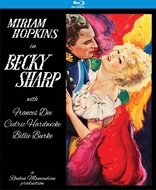Becky Sharp Blu-ray Movie
HomeBecky Sharp Blu-ray Movie 
Kino Lorber | 1935 | 85 min | Not rated | Apr 16, 2019Movie rating
7.2 | / 10 |
Blu-ray rating
| Users | 0.0 | |
| Reviewer | 4.0 | |
| Overall | 4.0 |
Overview
Becky Sharp (1935)
Becky and Amelia are girls at school together, but Becky is from a "show biz" family, or in other words, very low class. Becky manages to insinuate herself in Amelia's family and gets to know all their friends. From this possibly auspicious beginning, she manages to ruin her own life, becoming sick, broke, and lonely, and also ruins the lives of many other "loved ones". The first full color, 3-strip Technicolor film.
Starring: Miriam Hopkins, Frances Dee, Cedric Hardwicke, Billie Burke, Alison SkipworthDirector: Rouben Mamoulian, Lowell Sherman
| Romance | Uncertain |
| War | Uncertain |
| Drama | Uncertain |
Specifications
Video
Video codec: MPEG-4 AVC
Video resolution: 1080p
Aspect ratio: 1.37:1
Original aspect ratio: 1.37:1
Audio
English: DTS-HD Master Audio 2.0 Mono (48kHz, 16-bit)
Subtitles
English SDH
Discs
Blu-ray Disc
Single disc (1 BD)
Playback
Region A (C untested)
Review
Rating summary
| Movie | 3.5 | |
| Video | 4.0 | |
| Audio | 4.5 | |
| Extras | 2.0 | |
| Overall | 4.0 |
Becky Sharp Blu-ray Movie Review
Reviewed by Dr. Stephen Larson January 14, 2021I've long been intrigued by milestones in the history of early cinema, especially the experimental use of color in silent films such as Albert Parker's The Black Pirate (1926) and Cecil B. De Mille's The King of Kings (1927). I first heard of Becky Sharp (1935) when I saw the TV documentary Glorious Technicolor (1998), which appeared on the DVD/Blu-ray of The Adventures of Robin Hood (1938). Production designer Robert Edmond Jones is often credited as the driving force behind designing the three-strip Technicolor for Becky Sharp. Jones helped select colors for the two-reeler La Cucaracha a year earlier.
Becky Sharp is based on William Makepeace Thackeray's mid-nineteenth century serial novel, Vanity Fair. Langdon Mitchell adopted it into the play Becky Sharp in 1899. It had its New York premiere in 1929. Paul A. Snell, a correspondent for The Cincinnati Enquirer, went to Hollywood to get the scoop on its film adaptation. Snell reported that nine months went into its preparation, production, and editing. Filming took more than one-third of a year alone. Lowell Sherman (Morning Glory) directed the first three weeks of production but became gravely ill. John Hay Whitney's Pioneer Pictures, which financed Becky Sharp, hired Rouben Mamoulian to replace Sherman. Mamoulian told a New York press corps the circumstances in June 1935: "[Sherman] had already shot two reels of Becky Sharp; I had not even read the script. They wanted me to step right in and continue to direct. Everything was ready, they insisted. The script was waiting. So were the actors and the cameras. All I had to do was come around to the studio next morning and direct. But that is not my way. Always before I have taken weeks and months in preparation. I always work on the script too. I know exactly what I want and what I must do to get it." (quoted in Annie Oakley's 6/12/35 column of The Windsor Star). According to Oakley, two reels were printed and cut. Mamoulian viewed them but they were not to his liking so he put them aside and shot all-new footage. He rewrote the script so it was more in line with the novel than the play. Mamoulian also cast three or four new actors and devised a different color backdrop. Mamoulian was a great choice to replace Sherman. Snell learned that Mamoulian had a reputation as one of the best color artists on the American and European stage. His use of color and colored lights stood out in the productions of, for example, Porgy, Marco’s Millions, and Congai, which were considered among the most sumptuous and atypical stage plays in the theater during that era.
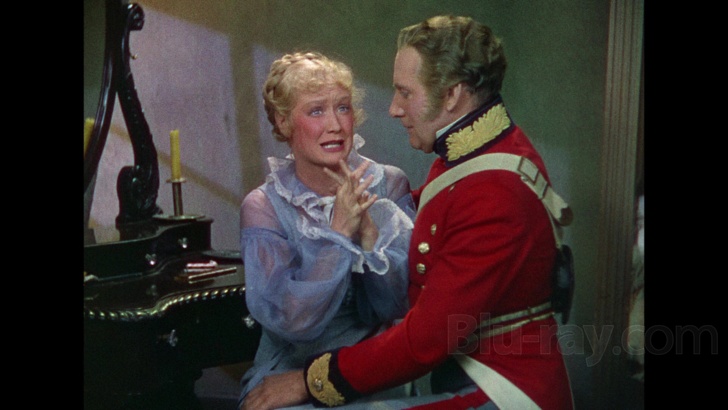
Miriam Hopkins was universally praised for her titular performance in the industry trades. Indeed, nearly all critics deemed her the perfect fit to play social climber Becky Sharp. The movie is set in early 19th century London where Becky ingratiates herself into the upper-class family of Amelia Sedley (Frances Dee). She becomes enamored of officer Rawdon Crawley (Alan Mowbray), whom she marries. But Becky also gets entangled with the Marquis of Steyne (Cedric Hardwicke) and Rawdon has serious misgivings about his wife's inclinations. In all, Becky tries to conquer six men. Becky Sharp works fine as a historical melodrama but Mamoulian's reworked script doesn't push it beyond the trappings of the genre.
The film's biggest highlight comes at the Duchess of Richmond’s Ball at Brussels (on the eve of the Napoleonic wars) where garish colors dominate. Herman G. Weinberg, a UK-based critic for Cinema Quarterly, commended Mamoulian's direction and his camera's fluidity of movement: "When Mamoulian allows for some movement in an otherwise static picture (such as in the whirling dancers at the Duchess of Richmond's ball, on the eve of Waterloo), the screen goes riotous with flaming scarlets, bright splashes of yellow and blue, soft greens and deep blacks with voluptuous visual beauty."
Becky Sharp received its first public screening at Radio City Music Hall on June 13, 1935. Kate Cameron of the Daily (NY) News wrote that the film was "greeted by a large and curious crowd that almost filled the vast auditorium. The spectators came with the expectation of being bowled over by something entirely new in the way of color photography. They were, I'm afraid, disappointed on that score, but they remained to applaud the efforts of all those concerned." Seymour Roman of the Brooklyn Times Union recounted the reception differently: Colors "are brought to the Radio City screen with such effectiveness yesterday's audiences frequently burst into spontaneous applause." The Associated Press called the reception mixed: "The first audience was divided in its opinion. Some expressed delight. Others complained that the colors taxed their eyes." I've seen figures that Becky Sharp cost over one million dollars to make and while it while it would have been nearly impossible for it to recoup its costs, audiences flocked to see it. The Hollywood Reporter observed box-office lines all day. It made somewhere between $16,000 and $18,000 on its first day and was projected to earn $100,000 for its first week alone.
Becky Sharp Blu-ray Movie, Video Quality 
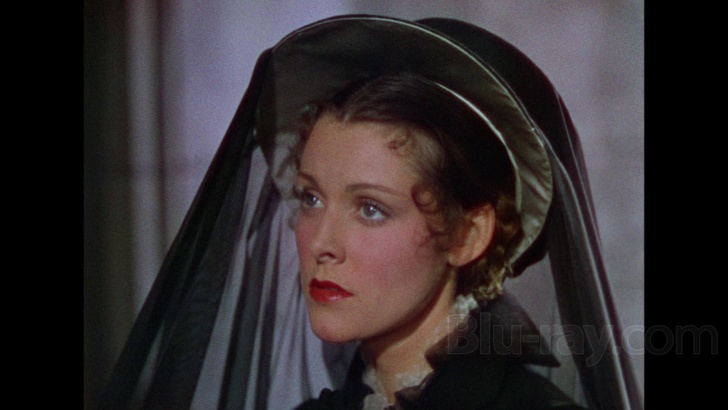
Kino Lorber Studio Classics has brought Becky Sharp to Blu-ray for the first time on this MPEG-4 AVC-encoded BD-25. (The film was never released on DVD by any of the majors or indie labels, though I'm aware of two SD editions, with one superior in quality over the other.) Kino advertised this release as a brand new 4K restoration sourced from the 35mm nitrate negative & positive separations. Before the film officially begins, the following text appears in white on two screens set against a black background: "The UCLA Film & Television Archive completed its initial restoration of BECKY SHARP in 1984. Since then, further improvements have been made, including a 2007 sound upgrade with funding provided by The Film Foundation and laboratory services provided by Audio Mechanics and DJ Audio. In 2017 the Paramount Archives, using the best of almost 50 reels of 35mm including the original surviving Technicolor 3-strip negatives, 3-strip positives, and prints, preserved this title in 4K at Technicolor Creative Services. Advanced digital tools were used to align the separation elements and clean the image. Sound preservation work was done at Deluxe Audio. Special thanks to Robert Gitt, Richard Dayton and Eric Aijala." Following the film's closing credits, Kino posts one more note about the restoration: "BECKY SHARP, the first feature film shot in the 3-color Technicolor process, was released in 1935. The film was subsequently shortened by 18 minutes and reissued in the 2-color Cinecolor process, which destroyed much of the effectiveness of the original, highly praised original design. After many years, BECKY SHARP has been returned to its original length and the full 3-color spectrum has been restored throughout most of the action. This new version was assembled from the best surviving Technicolor and Cinecolor materials."
The image boasts a thick texture. Damage marks have been kept to a minimum, though they show up on occasion. You'll notice some scratches in Screenshot #9 and a thin vertical tramline in #20. The transfer showcases the illustrious Technicolor spectrum. The colors coalesce with what reviewers said about the first release prints. The Chicago Tribune: "You will find the yellow sand a certain periwinkle blue the loveliest in reproduction. But the violets and greens are gorgeous and the red takes on an enchanting winey depth. Note especially the sunkissed appearance the process gives to the skin of the players, lending them a russet, windblown look." The aforementioned Snell commented that while the first half has the coolness and sobriety of colors like gray, blue, green, and pale yellow, the palette shifts to deep orange and flaming red once war breaks out. Weinberg noticed that long shots appeared blurred. They did look somewhat hazy on the Blu-ray. He added: "Close-ups darken the faces to such an extent that the players (especially Miriam Hopkins) look like mulattoes. The intense light (twice as much as for the black-and-white film) playing on the heavy make-up (necessary for players in colour films) probably accounts for this." Screenshot #s 21-25 are taken from the final reel where colors look more drenched and faded. Kino has encoded the feature at an average video bitrate of 29033 kbps.
Kino delivers eight scene selections.
Becky Sharp Blu-ray Movie, Audio Quality 
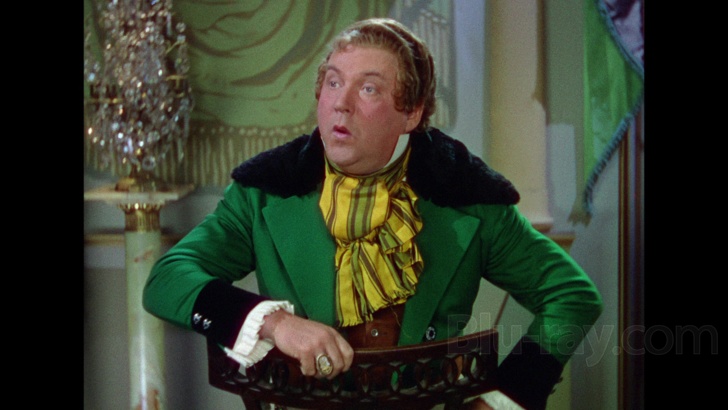
Kino has supplied a DTS-HD Master Audio Dual Mono mix (1557 kbps, 16-bit). Any discussion of Becky Sharp's monaural mix must take into account the original elements and re-recording. Restorers Robert Gitt and Richard Dayton wrote an outstanding and detailed article about the restoration of Becky Sharp for the November 1984 issue of American Cinematographer. They discussed the sound issues from the very beginning: "Our first project was to tackle the soundtrack, which, interestingly, also had presented problems to Becky Sharp's producers. Preview audiences in the spring of 1935 complained of a 'pumping' reproduction of the dialogue, bordering on unintelligibility. The RCA Photophone process, used to record Becky Sharp, was criticized at the time as being non-linear, although James G. Stewart of the RKO Sound Department, felt that the system was actually too linear and was picking up all of the variations in loudness and emphasis on certain words too accurately. The producers ordered the film's release held up for a month while the entire soundtrack was re-recorded by 'a new RCA process.' In actuality, this consisted of a desperate attempt to save the production by re-recording the photophone track on Western Electric's rival variable density system, exposed and developed so as to photographically 'limit' the audio peaks on the track. This was then re-recorded back to the Photophone process for the release prints. Unfortunately, the resulting audio, while undoubtedly an improvement, was still rather poor even by 1935 standards, and a strident, distorted 'pumping' quality was evident, particularly in Miriam Hopkins' voice." Jack Theakston makes reference to these matters in his audio commentary.
Kino has done yeoman's work in remastering the mono mix. There are no pops, clicks, dropouts, or bad hiss. Dialogue is comprehensible without the pumping sound.
Kino provides optional English SDH.
Becky Sharp Blu-ray Movie, Special Features and Extras 
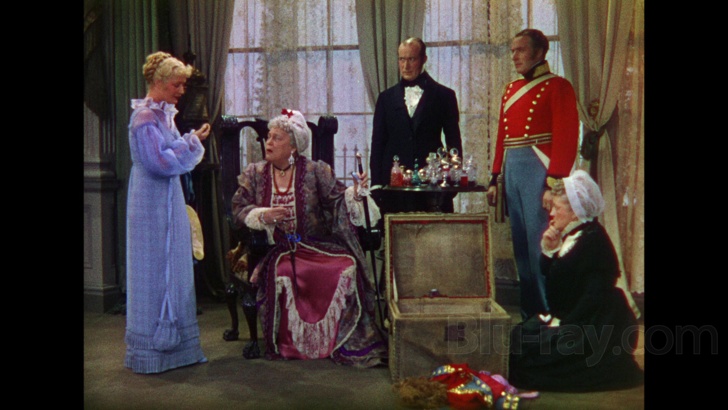
- NEW Audio Commentary by Film Historian Jack Theakston - Theakston gives a pretty comprehensive history of Technicolor and the production of Becky Sharp. He also goes over the filmmographies of cast and crew. He ends his commentary ten minutes before the film concludes. In English, not subtitled.
- Bonus Previews - trailers for other Kino Studio Classics titles: Nothing Sacred, The Adventures of Tom Sawyer, Intermezzo, The Young in Heart, Made for Each Other, Desert Fury, and Duel in the Sun. Unfortunately, there's no trailer for Becky Sharp.
Becky Sharp Blu-ray Movie, Overall Score and Recommendation 
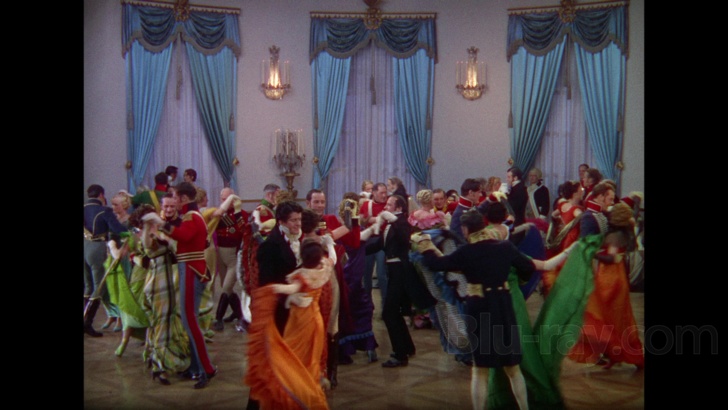
I've waited a long time for Becky Sharp to receive a respectable release on digital and Kino Studio Classics has delivered a very fine one that's based on a 4K restoration. The movie is worth watching more for its beautiful design than it is for its prosaic script and hohum narrative, though. Rouben Mamoulian's direction of actors is solid but I wouldn't go as far as The Hollywood Reporter did in 1935 when it said, "[Becky Sharp] is by far the best thing in direction that Mamoulian has done." The disc's audio commentary by Jack Theakston is a pretty informative track. I would have liked to see a restoration demonstration and 24-bit audio on the uncompressed mono. Still, the package comes HIGHLY RECOMMENDED.
Similar titles
Similar titles you might also like

Vanity Fair
2004

Camille
Warner Archive Collection
1936

Far from the Madding Crowd
Warner Archive Collection
1967

Grand Hotel
1932

Jane Eyre
Limited Edition to 3000 - SOLD OUT
1943

Love & Friendship
2016

Jane Eyre
2011

Great Expectations
1946

A Star Is Born
Restored Edition | Warner Archive Collection
1937

Imitation of Life
1934

Sadie McKee
Warner Archive Collection
1934

Washington Square
1997

Madame Bovary
Warner Archive Collection
1949

Dodsworth
Warner Archive Collection
1936

The Magnificent Ambersons
1942

Some Came Running
Warner Archive Collection
1958

The Heiress
1949

Saratoga
Warner Archive Collection
1937

Bel Ami
2012

Far from the Madding Crowd
2015
